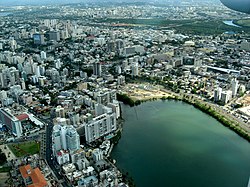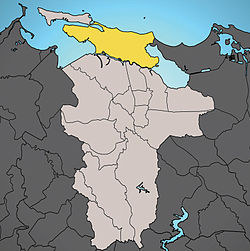Santurce | |
|---|---|
 Aerial view of Santurce in 2008 | |
 Location of Santurce shown in yellow within San Juan shown in light gray | |
| Commonwealth | Puerto Rico |
| Municipality | San Juan |
| Area | |
| • Total | 8.70 sq mi (22.53 km2) |
| • Land | 5.24 sq mi (13.57 km2) |
| • Water | 3.46 sq mi (8.96 km2) |
| Elevation | 49 ft (15 m) |
| Population | |
| • Total | 69,469 |
| • Density | 13,257.4/sq mi (5,118.7/km2) |
| (US Census 2020) | |
| Time zone | UTC−4 (AST) |
| ZIP Codes | 00907, 00908, 00909, 00911, 00912, 00913, 00914, 00915, 00916, 00936, 00940 |
Santurce (Spanish pronunciation: [sanˈtuɾse], meaning Saint George from Basque Santurtzi) is the largest and most populated barrio of the municipality of San Juan, the capital city of Puerto Rico. With a population of 69,469 in 2020, Santurce is also one of the most densely populated areas of the main island of Puerto Rico (13,257.4 persons per square mile) with a population larger than most municipalities of the territory.[2]
Founded as San Mateo de Cangrejos in the 1760,[3] Santurce officially became part of the municipality of San Juan in 1863.[4] From its original settlement, its history has been marked by diverse waves of immigration, particularly of Afro-Puerto Rican, Chinese, Jewish and Dominican communities who have left a cultural imprint in the area.[5][6][7][8] In the 20th century, it grew as a key economic and cultural center of San Juan with an influx of businesses, theaters, and hotels, making it one of the most significant cultural districts in Puerto Rico.[9][10][11][12] Today, Santurce's neighborhoods like Condado and Miramar have become popular tourist and commercial areas.[13]
- ^ U.S. Geological Survey Geographic Names Information System: Santurce Barrio
- ^ "Link to Puerto Rico – San Juan". Proyecto Salón Hogar (in Spanish). Retrieved November 29, 2012.
- ^ "Parroquia San Mateo/ Santurce – Arquitectura Histórica de Puerto Rico" (in Spanish). December 5, 2013. Retrieved October 10, 2020.
- ^ "Encyclopedia of Puerto Rico" (in English and Spanish). San Juan: Fundación Puertorriqueña de las Humanidades. OCLC 234072526. Retrieved May 24, 2017.
- ^ Martinez, Robert A. "African Aspects of the Puerto Rican Personality". ipoaa.com. Archived from the original on December 14, 2007. Retrieved March 22, 2016.
- ^ "SELECTED POPULATION PROFILE IN PUERTO RICO 2009-2011 American Community Survey 3-Year Estimates". Data Set: 2010 U.S. Census. U.S. Census Bureau. Archived from the original on February 12, 2020. Retrieved November 9, 2011.
- ^ Society For Crypto Judaic Studies, Harry Ezratty, Profile Archived April 30, 2008, at the Wayback Machine, cryptojews.com; accessed March 18, 2015.
- ^ "San Juan: Culture & Community". Reform Judaism. Retrieved December 6, 2022.
- ^ Teleview Productions (Emerson Yorke Studios). "Report on Puerto Rico, U.S.A. (1955)". Prelinger Archives. Retrieved July 13, 2010.
- ^ Bliss, Peggy Ann. "A walking tour of Santurce (Part II)". Puerto Rico Daily Sun. Retrieved April 5, 2010.
- ^ Adoquín, Periódico El (December 21, 2021). "Santurce: Un barrio levantado por el arte". Periódico El Adoquín (in Spanish). Retrieved October 25, 2024.
- ^ Diálogo, Por Especial para (October 31, 2015). "Santurce suena a diversidad". Diálogo UPR (in Spanish). Retrieved October 25, 2024.
- ^ "Exploring the Santurce Neighborhood". Discover Puerto Rico. Retrieved October 25, 2024.